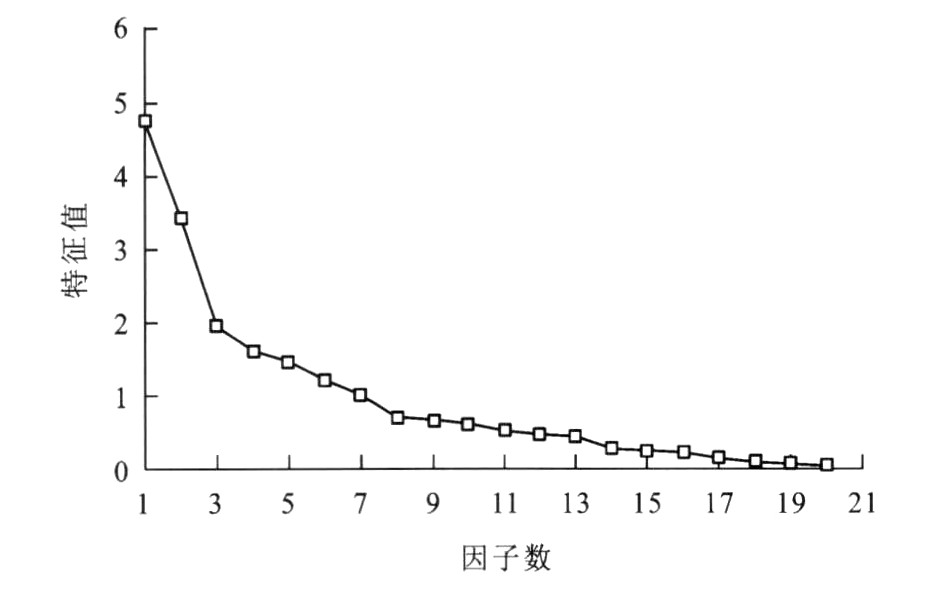-
摘要: 为了研究驾驶员的驾驶行为模式及人群聚类特点, 基于标准化驾驶员行为问卷开展了以中国非职业驾驶员为样本的驾驶行为自填式调查, 通过统计分析验证了问卷的有效性和可信性, 并基于因子分析方法, 从问卷结果中提取出驾驶能力因子和驾驶风格因子, 实现了对驾驶员驾驶行为模式的量化描述。进而以提取出的因子为特征, 采用模糊C均值聚类分析的方法建立了驾驶员行为模式的类别分布空间。对比分析表明: 驾驶能力因子值越大, 驾驶员驾驶能力越低; 驾驶风格因子值越大, 驾驶员驾驶风格越激进; 聚类结果与驾驶员主观自我评估的分布趋势一致, 能力偏弱、风格偏激进的聚类人群具有较高的事故驾驶员比率。Abstract: In order to study driver pattern and population clustering feature, driver behavior self-reported investigation for normal drivers was conducted with standardized driver behavior questionnaire(DBQ), and its validity and reliability of the questionnaire were verified based on statistics analysis.Driving ability factor and driving style factor were extracted from the questionnaire results to quantify driver characteristics with factor analysis method.Based on fuzzy C-means clustering algorithm, driver cluster distribution was established with the two factors as pattern features.Comparison result indicates that the higher the driving ability factor value is, the weaker the driving ability is; the higher the driving style factor value is, the more aggressive the driver style is.The clustering result has similar distribution tendency with driver subjective evaluation, and the clusters with weaker ability or more aggressive style have higher accident driver rate.
-
表 1 驾驶员行为问卷统计结果
Table 1. Statistics results of driver behavior questionnaire
题号 问题 平均值 标准差 相关系数R 1 跟车行驶时离前车过近 0.848 5 0.795 3 0.4711 2 在路口闯红灯 0.515 2 0.618 5 0.289 3 在城市道路上超速行驶 0.969 7 0.883 3 0.4731 4 在城际高速公路上超速行驶 0.939 4 0.899 3 0.4112 5 对某些类型的驾驶员比较反感, 并表达你的不满 1.636 4 1.025 2 0.4851 6 对外车道上慢速行驶车辆感到不耐烦而从内车道超车 1.515 2 0.795 3 0.5761 7 在道路上和其他车辆竞速斗气 0.515 2 0.618 5 0.4601 8 被某些车辆的不良驾驶行为激怒后追赶以表达愤怒 0.848 5 0.755 0 0.5241 9 按喇叭发泄对其他车辆或行人的不满 1.363 6 0.742 4 0.4142 10 在马上就要关闭的车道上行驶直到迫不得已时才换道 0.575 8 0.662 9 0.4392 11 从主路转弯进入小路时, 没有注意到穿过马路的行人 0.545 5 0.617 0 0.3672 12 当起步或换道时忘记观察后视镜 0.575 8 0.751 3 0.4382 13 在超车时低估了前面车辆的速度 1.030 3 0.809 5 0.321 14 在湿滑的路面上紧急刹车, 或在车辆打滑时打错方向 0.515 2 0.565 8 0.4731 15 在接近路口或环岛时进错车道 1.212 1 0.739 8 0.4931 16 在环岛上, 由于看错道路标志而走错出口 1.242 4 0.902 4 0.6921 17 忘记停车场内自己车的泊位 1.212 1 1.082 8 0.5871 18 倒车时, 撞到之前没有发现的障碍物 1.030 3 0.684 0 0.4601 19 计划驾车前往A地, 但途中突然发现正在驶向B地 0.575 8 0.662 9 0.5671 20 无法清晰的回忆起刚刚行驶过的路线 1.030 3 0.918 0 0.4441 总分数 18.697 0 7.380 2 1.000 注: 显著性水平在0.01以下, 认为上标为1的相关系数是显著的; 显著性水平在0.05以下, 认为上标为2的相关系数是显著的。 表 2 因子负荷矩阵
Table 2. Factor loading matrix
题号 问题行为属性 因子1 因子2 16 疏忽 0.795 20 疏忽 0.749 19 疏忽 0.746 11 失误 0.641 14 失误 0.638 18 疏忽 0.574 17 疏忽 0.554 15 疏忽 0.507 13 失误 0.469 12 失误 0.466 7 违规 0.804 8 违规 0.693 4 违规 0.682 3 违规 0.640 9 违规 0.612 6 违规 0.609 1 违规 0.595 2 违规 0.516 5 违规 0.366 10 违规 0.350 表 3 各个聚类的驾驶员特性
Table 3. Driver characteristic of each clustering
类别 样本数 驾驶员特性描述 聚类A 6 能力中性, 风格中性 聚类B 12 能力偏强, 风格偏激进 聚类C 5 能力偏强, 风格偏保守 聚类D 5 能力偏弱, 风格偏激进 聚类E 5 能力偏弱, 风格偏保守 -
[1] AUFRERE R, GOWDYJ, MERTZ C, et al. Perception for collision avoidance and autonomous driving[J]. Mechatronics, 2003, 13(10): 1149-1161. doi: 10.1016/S0957-4158(03)00047-3 [2] SUNDSTROM A. Self-assessment of driving skill—a review froma measurement perspective[J]. Transportation Research Part F: Traffic Psychology and Behaviour, 2008, 11(1): 1-9. doi: 10.1016/j.trf.2007.05.002 [3] SHI NAR D, SCHECHTMAN E, COMPTON R. Self-reports of safe driving behaviors in relationship to sex, age, education and income in the US adult driving population[J]. Accident Analysis and Prevention, 2001, 33(1): 111-116. doi: 10.1016/S0001-4575(00)00021-X [4] OZKAN T, LAJUNEN T. What causes the differences in driving between young men and women-the effects of gender roles and sex on young drivers driving behaviour and self-assessment of skills[J]. Transportation Research Part F: Traffic Psychology and Behaviour, 2006, 9(4): 269-277. doi: 10.1016/j.trf.2006.01.005 [5] KI NG Y, PARKER D. Driving violations, aggression and perceived consensus infractions au code de la route, agressivite et consensus percu[J]. Revue Europeenne de Psychologie Appliquee, 2008, 58(1): 43-49. doi: 10.1016/j.erap.2006.05.001 [6] LAJUNEN T, PARKER D, SUMMALA H. The manchester driver behaviour questionnaire: a cross-cultural study[J]. Accident Analysis and Prevention, 2004, 36(2): 231-238. doi: 10.1016/S0001-4575(02)00152-5 [7] XIE C Q, PARKER D. A social psychological approach to driving violations in two Chinese cities[J]. Transportation Research Part F: Traffic Psychology and Behaviour, 2002, 5(4): 293-308. doi: 10.1016/S1369-8478(02)00034-7 [8] OZKAN T, LAJUNEN T, SUMMALA H. Driver behaviour questionnaire: a follow-up study[J]. Accident Analysis and Prevention, 2006, 38(2): 386-395. doi: 10.1016/j.aap.2005.10.012 [9] PARKER D, LAJUNEN T, STRADLI NG S. Attitudinal predictors of interpersonally aggressive violations on the road[J]. Transportation Research Part F: Traffic Psychology and Behaviour, 1998, 1(1): 11-24. [10] 张磊, 李升波, 王建强, 等. 基于神经网络方法的集成式驾驶员跟车模型[J]. 清华大学学报: 自然科学版, 2008, 48(11): 1809-1812. https://www.cnki.com.cn/Article/CJFDTOTAL-QHXB200811025.htmZHANG Lei, LI Sheng-bo, WANG Jian-qiang, et al. Com-posite driver car-following model based on neural network approach[J]. Journal of Tsinghua University: Science and Tachnology, 2008, 48(11): 1809-1812. (in Chinese) https://www.cnki.com.cn/Article/CJFDTOTAL-QHXB200811025.htm [11] 李凤芝, 李昌吉, 詹承烈, 等. 攻击性驾驶行为量表中文译本的效度和信度[J]. 中国行为医学科学, 2003, 12(3): 335-337. doi: 10.3760/cma.j.issn.1674-6554.2003.03.057LI Feng-zhi, LI Chang-ji, ZHAN Cheng-lie, et al. The reli-ability and validity of aggressive driving questionnaires in Chinese version[J]. Chinese Journal of Behavioral Medical Science, 2003, 12(3): 335-337. (in Chinese) doi: 10.3760/cma.j.issn.1674-6554.2003.03.057 [12] XIE X L, BENI G. Avalidity measure for fuzzy clustering[J]. IEEE Transactions on Pattern Analysis and Machine Intelli-gence, 1991, 13(8): 841-847. [13] BENSAID A M, HALL L O, BEZDEKJ C, et al. Validity-guided(re)clustering with applications toi mage segmentation[J]. IEEE Transactions on Fuzzy Systems, 1996, 4(2): 112-123. -





 下载:
下载:








